By OLIVER WEBB
Images courtesy of Marvel Studios.
By OLIVER WEBB
Images courtesy of Marvel Studios.

Loki (Tom Hiddleston) watches as the TVA’s consoles turn into spaghetti amid the Spaghettifacation of time.
Created by Michael Waldron for Disney +, the second season of Loki follows notorious Marvel villain Loki (portrayed by Tom Hiddleston), Thor’s adopted brother and God of Mischief. The series takes place after the events of Avengers: Endgame and is set within the Marvel Cinematic Universe. Season 2 sees Loki team up with Mobius (Owen Wilson), Hunter B-15 (Wunmi Mosaku) and other Time Variance Authority (TVA) agents after he finds himself lost between past, present and future and in search of Sylvie (Sophia Di Martino), Judge Renslayer (Gugu Mbatha-Raw) and Miss Minutes (Tara Strong) as he navigates the multiverse.
Christopher Townsend served as Visual Effects Supervisor on the show. “I loved Loki Season 1, so when the opportunity came up to be a part of the second season, I was thrilled,” Townsend says. “Coming from features, it’s my first foray into streaming and longform storytelling, and I really enjoyed the pace and narrative breathing room that it afforded.”

Mobius (Owen Wilson), an investigating analyst who works with Loki, dons a protective suit to keep from getting shredded by the branching timelines of the Temporal Loom at the Time Variance Authority (TVA), the organization that monitors timelines in the multiverse and where raw time is refined into physical timeline.
Townsend spent considerable time discussing the aesthetics and aims of the show with Marvel Studio’s Executive Producer Kevin Wright, Justin Benson and Aaron Moorhead, directors of four episodes and Executive Producers of the series. “Along with Isaac Bauman, Director of Photography (for five of six episodes), Kasra Farahani, Production Designer (and director of Episode 3) and Dan Deleeuw (director of Episode 2), we talked about wanting to create a show with an analogue look and almost lo-fi feeling,” Townsend explains. “Set design, camera and lighting created a beautiful palette with which VFX worked, and our aim was to enhance and add to what was there and work within the styles set. Many discussions were had with the individual VFX vendors to ensure that we all worked within the same visual language.”
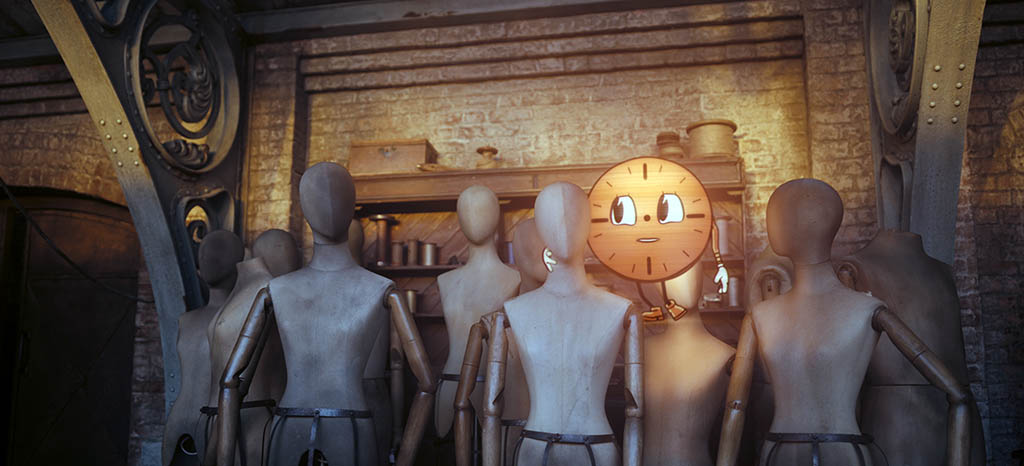
Miss Minutes (voiced by Tara Strong), an AI-driven character in the form of an orange clock who appears throughout the series spreading propaganda on behalf of the TVA, sometimes appears as an image on a screen but often pops up as a free-standing hologram, courtesy of Rising Sun Pictures.
“[W]e talked about wanting to create a show with an analogue look and an almost lo-fi feeling. Set design, camera and lighting created a beautiful palette with which VFX worked, and our aim was to enhance and add to what was there and work within the styles set. Many discussions were had with the individual VFX vendors to ensure that we all worked within the same visual language… We also finessed things further, where we could, including the look of the time doors, deletion effects and Loki magic, adding a further dose of photographic and gritty reality.”
—Christopher Townsend, Visual Effects Supervisor

Former TVA judge Ravonna Renslayer (Gugu Mbatha-Raw), who wakes up in the Void at the End of Time, and Miss Minutes (voiced by Tara Strong).
In terms of visual references, there were various things that Townsend and his team wanted to honor, either that was MCU canon or had been established in Loki‘s first season. “We also finessed things further where we could, including the look of the time doors, deletion effects and Loki magic, adding a further dose of photographic and gritty reality,” Townsend describes. “Throughout the season, there were many new effects and environments. For each, we studied a full gamut of diverse references as inspiration. For example, for Time Slipping we looked at long and multiple exposure photography, cubist paintings and portraits by Francis Bacon; for the Temporal Loom, everything from kelp forests, balls of yarn, electrical storms and deep space photography was studied; and in order to create something tangible for the Spaghettification effect, the evisceration of characters and environments, string, wire and yes, spaghetti!”
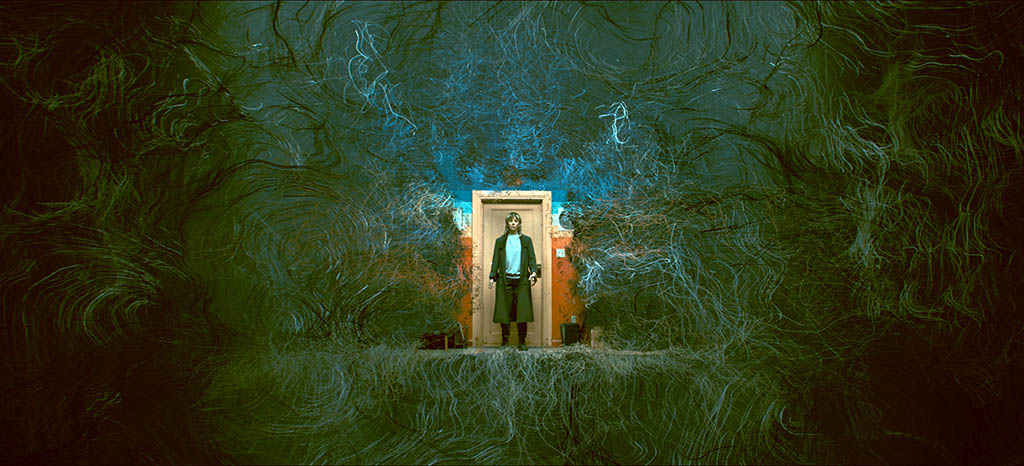
Sylvie (Sophia Di Martino) steps through a Time Door.
When it came to approaching the workload with his team, Townsend notes that good casting for VFX is as important as it is for actors in a show. “Partnering with the best creative teams that can create the visuals is paramount. After identifying the specific and diverse challenges, we picked seven different companies throughout the world. I need to thoroughly understand the creative and then brief the team. I’m a big fan of empowering the team of artists to create the solution. I’ll guide rather than dictate, as often that creates the best and sometimes the most unusual outcomes.”
There were several locations throughout the show that relied heavily on VFX. “One of these locations included the 1893 Chicago World’s Fair (with VFX handled by ILM], a beautiful and huge practical set built on the studio backlot, but which has a massive VFX set extension, including the world’s first Ferris Wheel,” Townsend says. “The Expanse [handled by Framestore], the infinite cityscape outside the TVA Chronomonitor offices, was a total redesign of what was seen in the first season. Creating something which is familiar and impossible at the same time is incredibly challenging. We decided to lean into the hazier look of Season 2 with more depth-cueing and more dramatic lighting, ending up with a more photographic look while maintaining a surreal quality.”
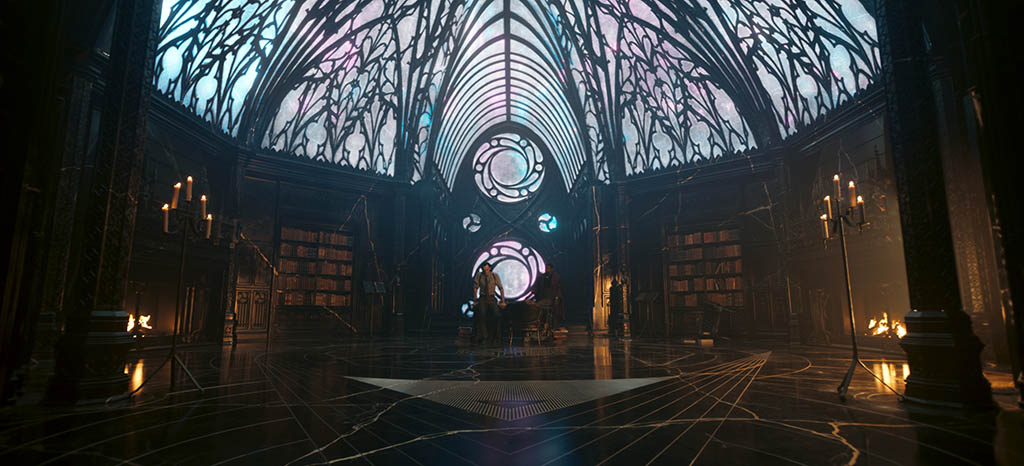
Loki and He Who Remains (Jonathan Majors) in the Citadel at the End of Time.
“However, probably the hardest location to create was the Temporal Core environment [created by Trixter] where we see the galactic Loom weaving time together,” Townsend continues. “The massive scale of the Loom, its importance within the entire season and the narrative storytelling of what it’s actually doing, told through animation and multiple different stages of increasing overload, was a huge challenge. Filling the space with increasingly powerful solar winds and prismatic flares helped to describe the volume and show the physical danger, but finding the looks of those elements was a long journey. In the first and last episodes, we see what effect the environment has as it shreds [almost entirely CG] characters’ oversized suits in a dramatic fashion. Set against the infinite exterior wall of the TVA building, with temporal probes and a delicate gangway, the world had to be both beautiful and ominous and work throughout the series in many guises.”
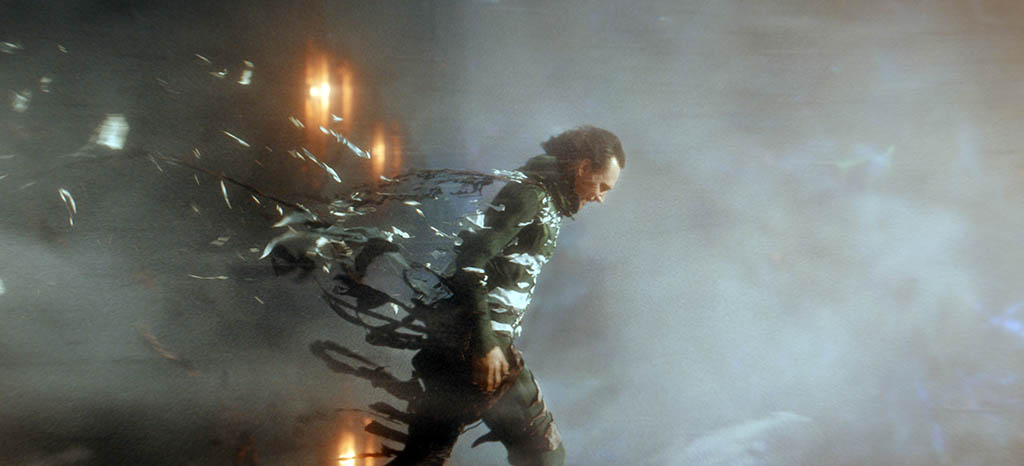
Shot on a bluescreen set with wind machines, Loki resists the ravages of time as his powers allow him to withstand Spaghettification.
“Throughout the season, there were also many new effects and environments. For each, we studied a full gamut of diverse references as inspiration. For example, for Time Slipping we looked at long and multiple exposure photography, cubist paintings and portraits by Francis Bacon; for the Temporal Loom, everything from kelp forests, balls of yarn, electrical storms and deep space photography was studied; and in order to create something tangible for the Spaghettification effect, the evisceration of characters and environments, string, wire, and yes, spaghetti!”
—Christopher Townsend, Visual Effects Supervisor
Kevin Yuille served as FuseFX VFX Supervisor on Season 2 of the show, having previously worked as Compositing Supervisor on the first season. Yuille and his team’s work primarily involved FX setups, such as those for time doors and deletions. Says Yullie, “We had an enjoyable project involving a set extension: transforming an abandoned Indian restaurant into a 1980s McDonald’s. We built the retro sign, accounting for the ‘billions served’ number from 40 years ago. While seemingly straightforward, there’s a sense of satisfaction in crafting something that seamlessly deceives the audience into believing nothing has been altered. We received concept artwork and blueprints of the original McDonald’s roof design from the client, which served as our guide in aligning features with the existing structure of the Indian restaurant. Maintaining the overhang of the entryway and the curved-glass facade was essential. Although most 1980s McDonald’s had a standard rectangular design with a mansard roof, we embraced unique layouts and designs for authenticity. Once the model was built and textured, we moved on to the shot work. Each shot required a camera track, essentially replicating the real camera for use in CG software like Maya and Houdini. In compositing, we meticulously painted out and removed exposed parts of the Indian restaurant that protruded too far, replacing them with the CG roof. Rotoscoping ensured the practical structure seamlessly met the roofline. The focus then shifted to matching the natural lighting in the scene, with CG providing compositors with lights to precisely integrate the roof into each shot. Ultimately, this task showcased the art of invisible VFX, and most viewers were unaware that the roof was a CGI creation.”

Revealing Loki at the heart of a galactic Yggdrasil tree, developed by Framestore, was one of the final shots of the series and one the most challenging VFX shots to create. The giant tree was assembled with complex simulations weaving together timeline ‘foliage’.
FuseFX was also tasked with redesigning the original Time Door and creating the torture device known as the Gizmo. “The Gizmo served as an extension of the Time Door setup, sharing a nearly identical set of renders and AOVs from FX but treated differently in compositing to achieve a distinct appearance,” Yuille details. “Unlike the vertical slab of glass in the Time Door, the Gizmo took the form of a versatile giant cube capable of adapting to various sizes. Initially expansive, it acted like a trap for any object or person, resembling a powerful trash compactor. Once enclosed, resistance against its walls proved futile, and as the walls contracted the trapped entity was gradually compressed. The unique look was largely achieved through a seamless hand-off of FX renders and AOVs to the compositing phase where they were utilized to create the refraction and reflection effects. Distinguishing itself from the Time Doors, the Gizmo featured internal reflections, enhancing the integration of people and objects with the internal walls. Some reflections were extracted from on-set plates where actors were filmed against moving planes of plexiglass. Others were renders from FX or compositing techniques involving flipping performers or using Nuke to project performances onto cards, capturing reflections from surfaces through Nuke’s ray-tracing renderer. This sequence was a particularly enjoyable project and stood out as one of the significant accomplishments for FuseFX in the show this season.”

Loki, Mobius, O.B. (Ke Huy Quan), who is TVA Chief Engineer, and Hunter B-15 (Wunmi Mosaku), former high-ranking TVA soldier, in the heart of the TVA.
In total, FuseFX successfully delivered 188 shots across all six episodes of Loki Season 2. “The standout episode was undoubtedly the second, marked by extensive McDonald’s set extensions and the more extended Gizmo sequence. Working on this show was immensely satisfying, whether considering our pride in the work or the fantastic collaboration with the Marvel team,” Yuille remarks.

Loki, Mobius and O.B. in O.B.’s workspace in the TVA. (Photo: Gareth Gatrell)
Rising Sun Pictures was another key visual VFX provider for Season 2. The studio’s primary role was to animate Miss Minutes, an AI driven character in the form of an orange clock who appears throughout the series spreading propaganda on behalf of the TVA, which monitors timelines in the multiverse. Miss Minutes appeared in Loki’s debut season, but her role grew considerably in Season 2, undergoing a sinister transformation. “She changes from a happy, charming AI assistant to one that is angry, power-hungry and, ultimately, deranged,” explains RSP Visual Effects Supervisor Julian Hutchens. “She becomes more and more out of control.”


In Episode 3, Miss Minutes travels back in time to 1893 Chicago when the city hosted the World Columbian Exposition. Here she assumes a ghostly appearance and grows to immense size, frightening a crowd attending the Exposition.
Bringing Miss Minutes to life was challenging. She sometimes appears as an image on a screen but more often pops up out of the blue as a free-standing hologram. Although superficially low-tech, she is the product of sophisticated technology. “She is her own light source and projector,” Hutchens explains. “She’s transparent, but also light emitting. If there’s polished metal in the room, she casts a reflection. It was fun playing with the notion that she occupies her own world, her own space, even as she is standing on a table or touching something real.”
“Creating something which is familiar and impossible at the same time is incredibly challenging. We decided to lean into the hazier look of Season 2 with more depth-cueing and more dramatic lighting, ending up with a more photographic look while maintaining a surreal quality.”
—Christopher Townsend, Visual Effects Supervisor
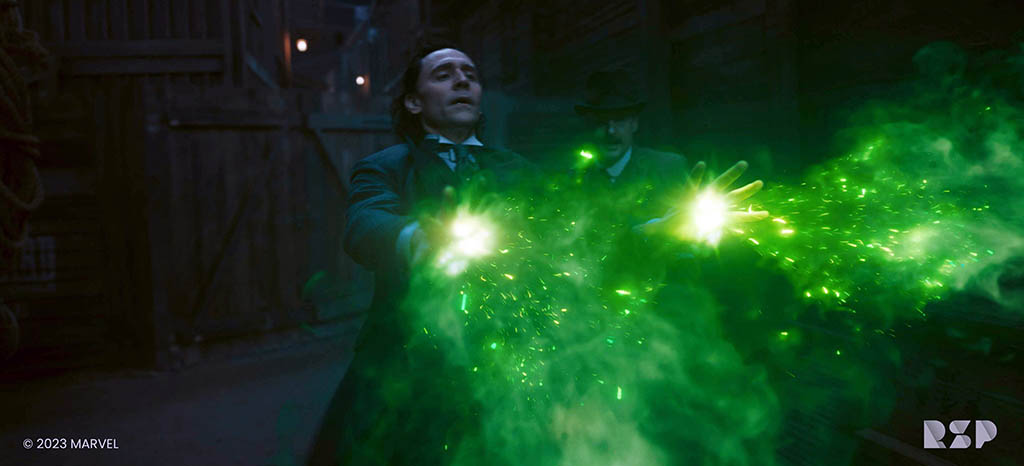
Rising Sun Pictures created Loki’s signature green energy blasts used in several scenes.
Miss Minutes’ thought processes and mood swings were captured through subtle changes in expression and movement – a curve of the lip or a flick of the wrist. “We tried to bring out the human element,” CG Supervisor Mathew Mackereth explains. “We’d ask ourselves, ‘What is she thinking?’ That became the bedrock of each shot, and we built from there. A shrug of the shoulders or a shift in position can convey a lot. So, the naivete and simplicity of the character were actually plusses. We could lean into her facial features and create a character with range and nuance.”
Recreating the aesthetics of 100-year-old cartoon animation was also challenging and had the team digging deep into their digital toolkit. “Miss Minutes is a 3D character that’s meant to look hand-drawn,” Mackereth explains. “You see it in the way the eyes work, the way they pop, the malleability of the mouth. Those details are relatively easy to draw but hard to engineer. It was a grueling process, but our animators loved it. We’re a VFX studio, but on this project we functioned more like an animation team.”


Recreating the aesthetics of 100-year-old cartoon animation was challenging and had Rising Sun Pictures’ VFX team digging deep into their digital toolkit to capture Miss Minutes, whose design was inspired by vintage cartoons such as Felix the Cat.
In Episode 3, Miss Minutes travels back in time to 1893 Chicago, when the city hosted the World Columbian Exposition and its display of what was then cutting-edge technology. In doing so, her appearance changes, taking on the look of the early animation of the period. “She flips a switch, spins around and becomes a black & white version of herself,” Hutchens relates. “Her face design changes. Her eyes become simpler, with triangle cut-outs like Betty Boop. We also added jitter and other imperfections to give her image the endearing, throwback quality of early animation.”


Rising Sun Pictures created a digital extension of an elaborate practical set representing a blighted working-class section of Chicago. Drawing on a host of archival references, artists reproduced wood-frame tenements, trash-strewn streets and other period environmental features.
As the season progresses, Miss Minutes’ behavior becomes stranger and more erratic. In Episode 3 she assumes a ghostly appearance and grows to immense size, frightening a crowd attending the Exposition. In a later episode, she begins to seriously malfunction. “We wanted to show her passing through a series of states of stress,” Hutchens recalls. “We show her glitching more and more as her processing goes awry. Ultimately, we built a 3D rig and used it to create a skeleton of ASCII code, as if her whole body were made up of ones and zeros. The sequence builds until she fails completely.”

Loki and Mobius at the 1893 Chicago World’s Fair, recreated by ILM on a huge practical set built on the studio backlot with a massive VFX set extension, including the world’s first Ferris Wheel.
One of the requirements of the show was the process of stitching together Loki’s time slips. “Time Slipping [handled by Framestore] was an effect we had a lot of fun creating. We concepted many different looks before finally ending up with the dramatic effect seen,” Townsend remarks. “Once the hero performance take was done, we’d have all the other actors step off set, we’d bring out a small greenscreen, repeat the camera action and have Tom give us a variety of different actions that we could use as interstitial poses. I asked him to give us a range of slow, aggressive, swirling, reaching, painful, stoic and fast actions, and once we had all the pieces we shot a clean background plate without Tom. With all of those different passes, Editorial would create a cut showing the intended pacing of the moment, and VFX then selected individual bits from the different passes and slap-comp them together. Once Editorial was happy with the selects, we tracked the poses and created 3D versions of them. We simulated a gooey, stretchy, taffy-like connection between the actions, rendered it out with appropriate colors and textures for skin, clothing and hair, then carefully comped it together. Once we were happy with that stage, we hand painted an added layer of gruesomeness and gore in select places to make the effect feel even more painful and shocking. It was a great collaboration of brilliant and committed performances from Tom and our VFX team, who tackled the challenge with artistic sensitivity and finesse. Everyone knew what was required, and we all knew what we were aiming for.”
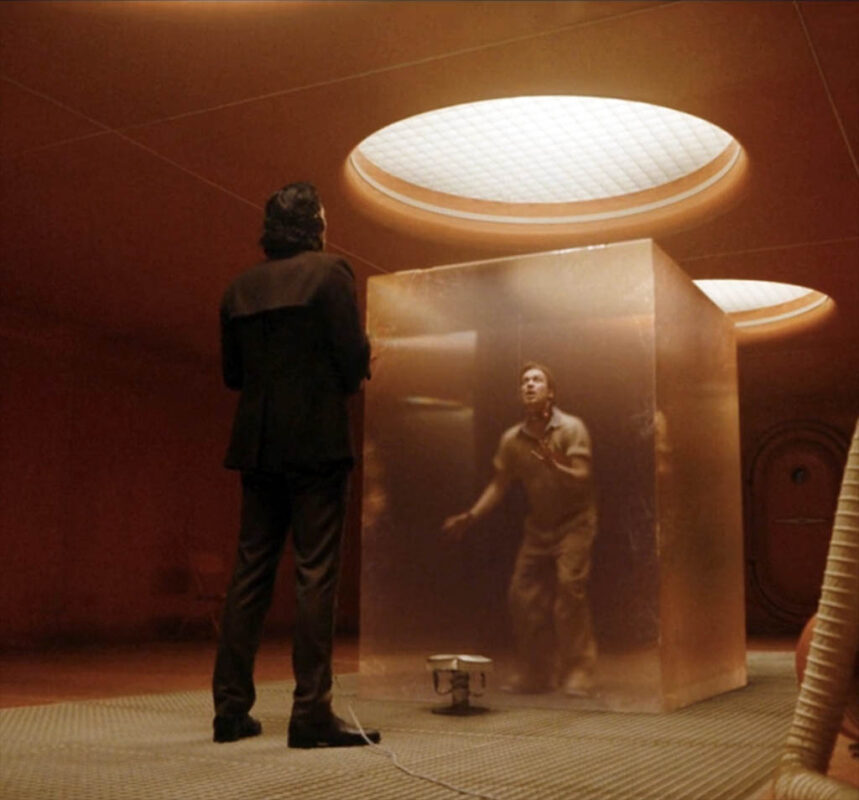
FuseFX was in charge of creating the Gizmo, a giant cube capable of adapting to various sizes. Initially expansive, it acted like a trap for any object or person, resembling a powerful trash compactor. Once enclosed, resistance against its walls proved futile, and as the walls contracted the trapped entity was gradually compressed.
“However, probably the hardest location to create was the Temporal Core Environment [created by Trixter], where we see the galactic Loom weaving time together. The massive scale of the Loom, its importance within the entire season, and the narrative storytelling of what it’s actually doing, told through animation and multiple different stages of increasing overload, was a huge challenge.”
—Christopher Townsend, Visual Effects Supervisor

FuseFX transformed an abandoned Indian restaurant into a 1980s McDonald’s. Although most 1980s McDonald’s had a standard rectangular design with a mansard roof, in compositing the FuseFX team meticulously painted out and removed exposed parts of the restaurant that protruded too far, replacing them with a CG roof.
Overall, there were 1,210 visual effects shots created by seven different companies: Framestore, Trixter, Industrial Light & Magic, Rising Sun Pictures, FuseFX, Cantina Creative and Lola VFX. Allison Paul was the VFX Producer, Sandra Balej was the Additional VFX Supervisor, and Harrison Goldstein was the Associate VFX Producer. One of the most challenging visual effects shot to create for the show was one of the final shots of the series. “Revealing Loki at the heart of a galactic Yggdrasil tree formation was probably our most challenging shot [created by Framestore],” Townsend details. “It’s a long powers of 10 [shot], with complex simulations weaving together timelines as we race out, and rendering the multiple layers became a challenge in its own right. However, creatively finding just the right balance of delicate simulations of the blossoming, branching, blue and purple timeline ‘foliage’ set against the green boughs of the tree, the galactic cloud formation and camera move to show parallax and scale and the definition of the circular motif that leans into Norse mythology – those were the real challenges to create what is hopefully a beautiful and iconic image in the MCU.”
Watch videos of Framestore, Trixter and Rising Sun Pictures’ VFX work for Season 2 of Loki. Click here: https://www.framestore.com/work/loki-season-2?language=en, https://www.trixter.de/projects/loki-season-2, https://www.rsp.com.au/our-work/filmography/loki-season-2/.